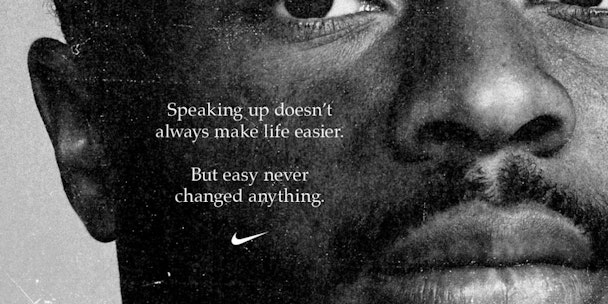Stand for something or stand for nothing, data’s role in tapping into culture
Manchester City’s Raheem Sterling is the latest sportsman to feature in Nike’s ‘Just Do It’ ad campaign following his recent comments on the media’s portrayal of young black footballers. The campaign is an example of the ongoing trend for brands to take a stance on some of today’s most pertinent social issues. The hard question to answer is: what’s the ROI of culture?

Raheem Sterling is the latest sportsman to feature in Nike’s ‘Just Do It’ ad campaign
I'm having more and more conversations with clients on attribution modelling, and what I find encouraging is the number of clients who are open to measure not just the obvious ‘vanity metrics’ of clicks and views, but more the ‘why’ behind the seas of data. This requires a lot of groundwork, but it can and should be done.
Until I'm doing this for every client, which I hope is one day soon, I've made some assessments on what it is that seems to be working. And interestingly, what seems to be working best are brands tapping into culture. It sounds intangible, unmeasurable. But on the contrary, the brands leading the digital charge understand one thing in these strange times: it's no longer acceptable to be on the fence anymore. Stand for something, or stand for nothing.
The brands leading the way are doing so with meaningful marketing. The world is a pretty confusing place lately, and people are looking to purchase from brands that exhibit values that align with their own. We see brands like Dove, Nike, Patagonia, and REI doing this incredibly well while connecting meaningfully and becoming a living, breathing picture of their ethos in order to build long-term connections with their consumers.
A lot has happened in the past few years; it's been a highly emotive time with ramifications no one predicted. Brands have historically trodden very carefully when it comes to politics and using any divisive language to deter away any part of a very wide audience. However, today those 'safe' comms are certainly being challenged by consumers as they demand to know more about what brands stand for if they are to part with their money.
Of course, there's no better example this year than Nike’s 'Just Do It' campaign which featured Kaepernick as its key brand ambassador. This was a hard pivot from mass appeal to a bold statement targeted to a more tailored and engaged audience. This issue and brand campaign fuelled huge debate in the US and no doubt, it did its homework before making a move like this. From what I’m able to gather, it was stated that it knew its target market would be encouraged, not angered by this. Nike gathered that less than 2% of its consumer base were the Kaepernick-condemning types (you know the ones… they’ve been wearing white Reeboks for the past three decades).
Sure this spurred a huge debate, but it also solidified its most valuable advocates: younger, urban, mixed race consumers who indeed responded overwhelmingly positively to this campaign and will undoubtedly create far more lifetime value as they will more strongly identify with Nike as a 'brand that represents me', and a brand that they share values with.
Of course, Nike arguably has some of the best marketing tactics on the planet, but this is unfolding all over the place:
- REI shutting their doors for Black Friday to live their true ethos of 'go outside'
- Patagonia shutting their doors and their website during elections to encourage voting
- Virgin Trains’ unapologetic stance on LGBT+ rights
- Coca-Cola focusing on inclusion and diversity with its Super Bowl ad
- Airbnb enforcing zero tolerance on anything shorter than 'absolute acceptance' from Hosts
The list goes on. This doesn't mean I'd encourage any brands to be extreme or rush to publicly identify a political leaning but to just know and communicate what you stand for as a brand.
As politics, environmental issues, and the slew of other matters continue to impact the human race, consumers expect brands they buy to be proactive in the world. They aren’t content with companies that are merely ‘not evil’ – they want their purchases to support positive change and seek to purchase with brands that represent them and share their values.
Perhaps my favourite most culturally relevant brand right now is Domino’s Pizza. It's recognised very particular patterns in its target audience of keen pizza-lovers – it thrives on digital. As a result, Domino’s have immersed themselves in a world of tech meets pizza, and now 60% of its revenue is derived from digital touchpoints (what’s a Pizza Hut?). Its doing brilliant work in partnerships, like the integration with IFTTT app (a widely used rules-based trigger app) where you create rules to trigger sending you a pizza. This partnership has resulted in literally creating new, culturally relevant moments to enjoy pizza where it didn’t exist before. It also has a bot where you can text to order, which of course tons of brands are doing, but Domino’s has really made it fun to engage with and ensures cultural relevance in all its comms:

Data and culture are colliding, and as a strategist and measurement professional, I hope we start tracking what's meaningful and we can step away from endless spreadsheets and campaign reports that carry exactly zero evidence on brand and revenue impact. We have to stop obsessing over the vanity metrics and zero in on the data that effectively measures what we’re trying to achieve as a brand.
Sarah Parrish is senior data planner at Proximity London.
